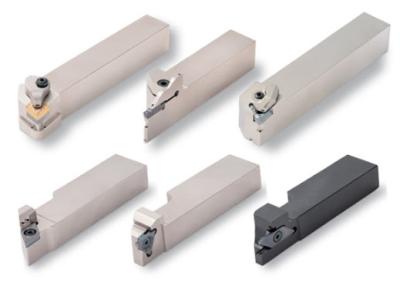
Kyocera Precision Tools' jet coolant-through toolholder series provides multiple high-pressure coolant streams at precise locations giving you the upper hand in chip control and wear prevention. The large JCT-Series tooling lineup has now been expanded to include all new inch-size holders. Learn how this series can improve your production line with excellent performance in a variety of turning, grooving, cut-off, and threading applications.
Double-Clamp-JCT
Turning
Utilizes multiple coolant streams to improve chip control and lengthen tool life for a wide variety of workpieces including steel, hardened steel and difficult-to-cut material.
KGBA-JCT
Shallow Grooving
Superior cooling action with the focused coolant stream directed between the chipbreaker and the chip to create stable chip curls and better cooling of the insert.
KGD-JCT
Gooving / Cut-off / Small Diameter Cut-off
Coolant is directed from the rake surface and the flank face of the insert for excellent chip control and longer tool life. A optimized coolant hole position for small parts cut-off discharges coolant precisely towards the rake face of the insert for better wear resistance.
KTN-JCT
Threading
Prevents chip recutting, clogging, and entanglement by directing coolant from the flank face of the insert to smoothly evacuate chips away from the cutting edge.
Screw-Clamp-JCT
Small Parts Turning
Double coolant holes provide coolant toward the cutting edge surface of the insert to efficiently cool the edge and provide greater wear resistance and longer tool life.
KGBF-JCT
Small Parts Grooving
Unique coolant hole design can eject coolant closer to the cutting edge than competitor products while keeping stream narrow to avoid pressure loss and provide stable chip curls.
KTKF-JCT
Small Diameter Cut-off
Double coolant holes break chips evenly into small pieces with excellent chip control performance when machining difficult-to-cut material and stainless steel.
Contact Details
Related Glossary Terms
- chipbreaker
chipbreaker
Groove or other tool geometry that breaks chips into small fragments as they come off the workpiece. Designed to prevent chips from becoming so long that they are difficult to control, catch in turning parts and cause safety problems.
- coolant
coolant
Fluid that reduces temperature buildup at the tool/workpiece interface during machining. Normally takes the form of a liquid such as soluble or chemical mixtures (semisynthetic, synthetic) but can be pressurized air or other gas. Because of water’s ability to absorb great quantities of heat, it is widely used as a coolant and vehicle for various cutting compounds, with the water-to-compound ratio varying with the machining task. See cutting fluid; semisynthetic cutting fluid; soluble-oil cutting fluid; synthetic cutting fluid.
- grooving
grooving
Machining grooves and shallow channels. Example: grooving ball-bearing raceways. Typically performed by tools that are capable of light cuts at high feed rates. Imparts high-quality finish.
- rake
rake
Angle of inclination between the face of the cutting tool and the workpiece. If the face of the tool lies in a plane through the axis of the workpiece, the tool is said to have a neutral, or zero, rake. If the inclination of the tool face makes the cutting edge more acute than when the rake angle is zero, the rake is positive. If the inclination of the tool face makes the cutting edge less acute or more blunt than when the rake angle is zero, the rake is negative.
- threading
threading
Process of both external (e.g., thread milling) and internal (e.g., tapping, thread milling) cutting, turning and rolling of threads into particular material. Standardized specifications are available to determine the desired results of the threading process. Numerous thread-series designations are written for specific applications. Threading often is performed on a lathe. Specifications such as thread height are critical in determining the strength of the threads. The material used is taken into consideration in determining the expected results of any particular application for that threaded piece. In external threading, a calculated depth is required as well as a particular angle to the cut. To perform internal threading, the exact diameter to bore the hole is critical before threading. The threads are distinguished from one another by the amount of tolerance and/or allowance that is specified. See turning.
- toolholder
toolholder
Secures a cutting tool during a machining operation. Basic types include block, cartridge, chuck, collet, fixed, modular, quick-change and rotating.
- turning
turning
Workpiece is held in a chuck, mounted on a face plate or secured between centers and rotated while a cutting tool, normally a single-point tool, is fed into it along its periphery or across its end or face. Takes the form of straight turning (cutting along the periphery of the workpiece); taper turning (creating a taper); step turning (turning different-size diameters on the same work); chamfering (beveling an edge or shoulder); facing (cutting on an end); turning threads (usually external but can be internal); roughing (high-volume metal removal); and finishing (final light cuts). Performed on lathes, turning centers, chucking machines, automatic screw machines and similar machines.
- wear resistance
wear resistance
Ability of the tool to withstand stresses that cause it to wear during cutting; an attribute linked to alloy composition, base material, thermal conditions, type of tooling and operation and other variables.
